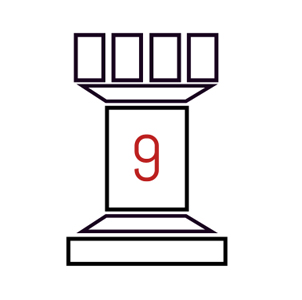One concept that becomes important for more advanced play is proper sequencing of your plays- arranging your moves in the right order. Even if you know your turn is going to involve using a certain set of cards, the order in which you use those cards can make a big difference. Similarly, pitching cards in the right order can be crucial when trying to set up future turns.
Broadly speaking, I think there are three main areas where sequencing matters:
- Avoiding Blunders
- Advanced Pitching
- Maximizing Advantages
Avoiding Blunders

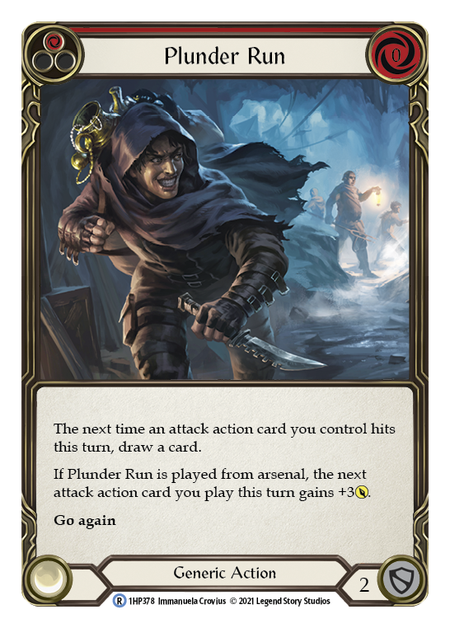
In some situations, doing things in an improper order can significantly weaken your turn. For instance, if you want to threaten Mask of Momentum on a Plunder Run turn as Katsu, you should play the Plunder Run before your very first attack of any type, even if that first attack is a Kodachi swing. While it might seem more intuitive to play Plunder Run immediately before your first attack action card, you won’t miss out on the benefit by playing Plunder Run before everything; but if you swing the Kodachi first and then play the Plunder Run, it’ll break the chain and “reset” your potential Mask of Momentum trigger.
Quick Tip: Plan your sequencing so you don't get tripped up by the rules and your own cards!
Advanced Pitching
The game allows you to pitch “inefficiently” (using cards that you don’t need to pitch), as long as you pitch in the right order! For instance, if I want to play a card that costs three energy and I have a blue card and a yellow card in hand to pitch with, I could pitch the yellow card first and then the blue to play the effect with two energy “floating” -- but if I pitch the blue card first I cannot then pitch the yellow without paying for some other effect.
Why would you want to pitch “inefficiently”, you might ask? There are two main reasons: first, to get a card out of your hand that you want to avoid having, and second to try and set up the bottom of your deck in a certain way.

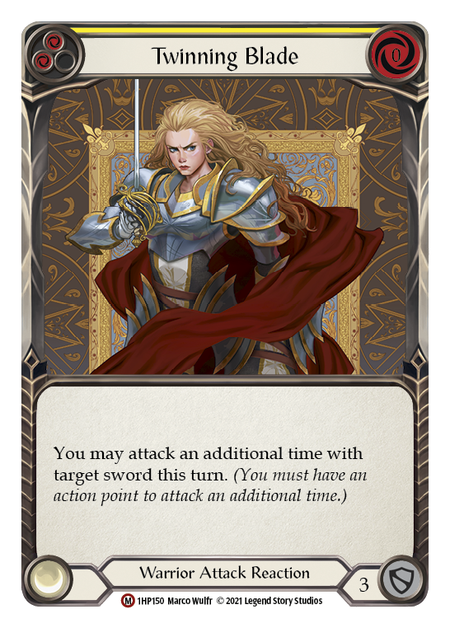
For instance, if you have two cards that go very well together- say a Twinning Blade and a Glint the Quicksilver- you might want to pitch inefficiently to ensure that the two of them will end up on the bottom of your deck together later in the game. (Note, however, that if you expect to shuffle your deck after a search effect like Singing Steelblade or Nock the Deathwhistle, this becomes less relevant.)
Quick Tip: Plan your Pitch out for the entire turn- then consider whether strategic over-pitching might be a beneficial cycle for you!
Maximizing Advantages
Even if you know what cards you want to play, sometimes differences in the order in which you play them can gain an advantage. You can use sequencing to hide information from your opponent, bluff a potential reaction/further attack, or give yourself the most “option value” for potential card draws that you might get later in your turn. This might not always deliver a lot of value, but can be quite strong under specific circumstances.
Some things to consider with respect to maximizing little advantages:
- Which attacks do I think my opponent is likely to block versus let through? Is there a way that I can “soften up” my opponent’s defenses before playing a strong on-hit effect?
Hit and Run > Dawnblade > Command and Conquer is a classic line of play from Dorinthea; someone may well block (or overblock!) the Dawnblade to prevent Dorinthea’s ability from triggering, only to find themselves struggling to block the C&C!
- Do some of these attacks draw me cards? If so, I probably want to use them earlier, if possible, as the drawn cards may be relevant to the rest of the turn.
If the card draws on hit (like Snatch), the potential to use that card in the rest of the turn can create a higher block priority for the opponent!
- If I can’t pay for everything I could potentially do, is there a way I can sequence my attacks so that I don’t have to commit to one option or the other until I see more of what my opponent does?
So, that’s a quick overview of sequencing. There’s likely more to it than I’ve outlined here- especially for Kano players- but I want to move to an example that can show how some of these principles might be applied in an actual game.
Sequencing in Action
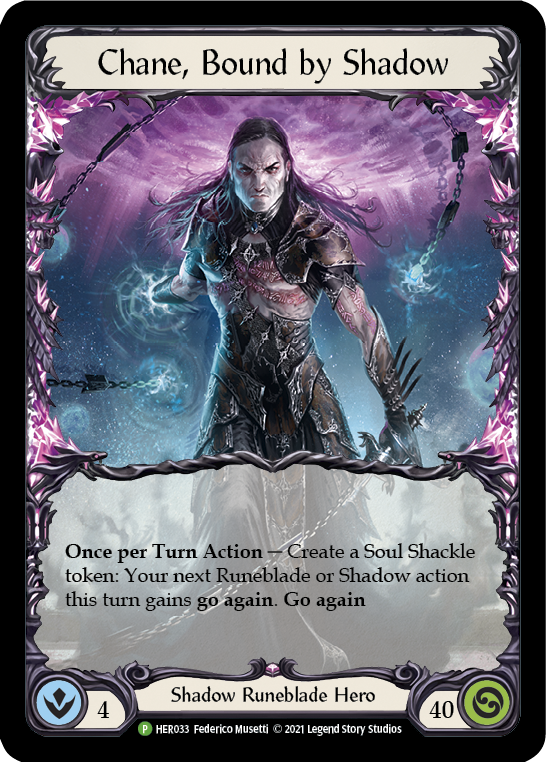

Let’s say you’re playing as Chane in a Blitz match against Dorinthea. After blocks, you have a red Rift Bind and a blue Seeds of Agony in hand, with a red Bounding Demigon and yellow Seeds of Agony in the banished zone. You have a Springboard Somersault waiting in arsenal. Your weapon is Nebula Blade and, for the purpose of this example, you have no relevant equipment.
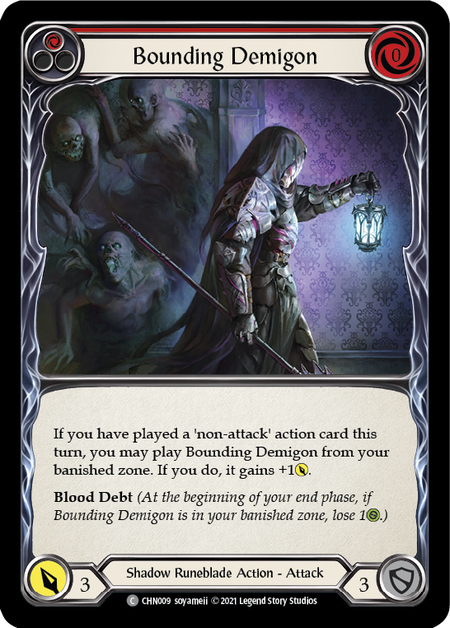
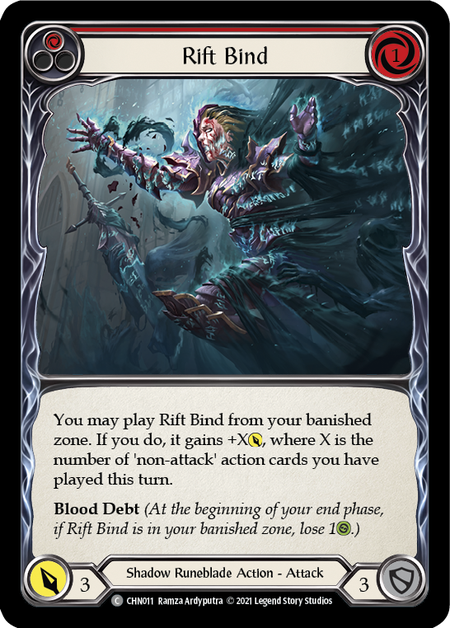
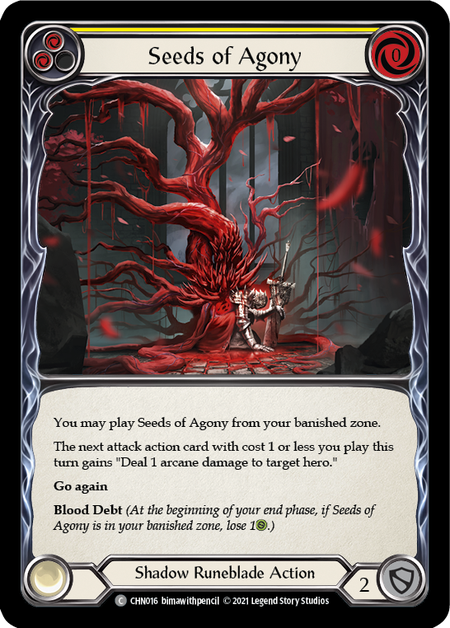
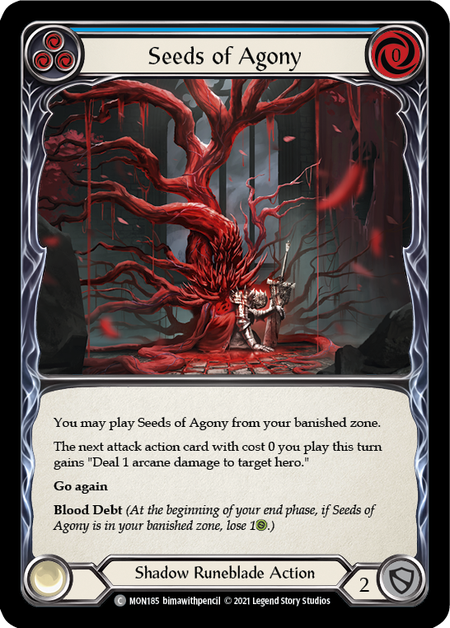
First, this hand is a bit awkward. Rift Bind is often a poor option when played from hand or arsenal- you really want to mill it with Soul Shackle, and then play it from the banished zone in order to get the bonus stats. To make matters worse, the Springboard Somersault in arsenal means that you can’t arsenal the Rift Bind even if you wanted to for bluffing purposes or “just in case”. As such, you want to pitch the Rift Bind in hopes that you banish it later- but you don’t have an efficient way of doing that since none of your effects cost one.
The solution is to pitch inefficiently via sequencing. When it comes time to swing your Nebula Blade, first pitch the Rift Bind for one and then the blue Seeds of Agony for three. This allows you to clear both of your cards from hand. Note that you must pitch the Rift Bind first in order to do this! Since you can only pitch to actually pay a cost, you need to sequence your pitch so that you pitch the “inefficient” card before the other in order to be able to pitch both. If you pitch the blue first, it pays for the attack completely and there’s nothing to pitch the red for!


But that’s not the only sequencing issue here.
You need to be careful to sequence your plays correctly to avoid blunders. There are two potential mistakes that I’ve made or seen other Chane players make in these sorts of situations:
- If you use Chane’s ability to make a Soul Shackle token before you take a Runeblade/Shadow action that already has go again, your Chane trigger will be wasted because go again doesn’t stack! You need to first play the card or use the effect with go again. This means that you may need to use Chane in between playing the Seeds of Agony from banish and the Bounding Demigon; if you use Chane and then immediately play Seeds you’ll waste the trigger!
- If you swing with Nebula Blade before playing the Seeds of Agony from banish, it will only be strength 1 instead of 4, as you won’t have played a non-attack action yet.

This could be the difference between playing out a strong turn and being stuck with either the Bounding Demigon damaging you in the banish zone or else the Rift Bind still stuck in hand/arsenal!
On a more advanced level, you need to consider the order in which you want to make those attacks in order to maximize little advantages. You could, in principle, play the Seeds of Agony from banish first, then use Chane’s ability, then swing the Nebula Blade and follow it up with the Bounding Demigon; alternatively, you could play the Seeds of Agony, use Chane’s ability, play Bounding Demigon, and then follow up with the Nebula Blade.
However, in this case I think the answer is relatively straightforward. If you swing the Nebula Blade first, using the inefficient pitch sequence I mentioned earlier, you’ll be left without any cards in hand so your entire turn will be “on the table”. However, if you use the Bounding Demigon (with Shackles) first, your opponent will not know what the cards in your hand represent; they may block the arcane damage from Seeds unnecessarily, fearing a red Meat and Greet. An unnecessary preventative measure like that would let you pitch blue, make another attack, and then swing the Nebula Blade as well. Therefore, the Demigon should be the first attack.
Putting all of this together, the turn looks like:
- Play Seeds of Agony (red) from the Banished Zone.
- Use Chane’s ability to give the next Runeblade/Shadow action go again.
- Play Bounding Demigon (red) from the Banished Zone.
- Swing with Nebula Blade, pitching first the Rift Bind (red) and then the Seeds of Agony (blue) so that both of the cards go to the bottom of your deck.
By sequencing carefully, you can play a much stronger turn than a newcomer might be inclined to play at first glance- but by sequencing poorly, you might find yourself suddenly in trouble!
Starting Somewhere
This is, of course, only the tip of the iceberg for some of these issues, and choosing the best way to play out a turn can at times be quite complex! (That goes double for Kano players; Wizard can face very complicated sequencing involving the distinction between playing and resolving cards!) With this basic overview in mind, you can start figuring out how to play your turns, especially with some of the more complicated heroes that we’re now seeing.
Quick Tip: If you find sequencing overwhelming or frequently make errors, not all characters are the same “difficulty level” to play! In general, I think that the characters have escalated in difficulty across the different “core sets”, with Welcome to Rathe heroes being the easiest, then Arcane Rising heroes, then Monarch ones.
Sequencing your turn carefully can bring substantial benefits. If you can sequence your turns to avoid blunders, use advanced pitching to clear poor cards from your hand or set up your deck for future turns, and do things in the proper order to maximize little advantages, you'll find yourself reaping the rewards of a strategy well executed!


